
IDEXX SDMA testing
SDMA resources at your fingertips.

SDMA resources
How to run the Catalyst SDMA Test.
Running an SDMA test on the Catalyst One Chemistry Analyzer.
- Initiate the sample run on the IDEXX VetLab Station.
- Load the pipette tips, sample, and SDMA slide into the analyzer. Additional slides/tests can be added as part of a comprehensive patient profile.
- Press the Start button on the analyzer.
Running an SDMA Test on the Catalyst Dx Chemistry Analyzer.
- Initiate the sample run on the IDEXX VetLab Station.
- Select the patient and sample type on your Catalyst Dx Chemistry Analyzer.
- Load the pipette tips, sample, and SDMA slide into the analyzer. Additional slides/tests can be added as part of a comprehensive patient profile.
- Tap Run on the analyzer.
Let simplicity be your guide.
Making the most of SDMA should be simple. And it is. Download these easy‑to‑understand guides and have everything you need to know close at hand.
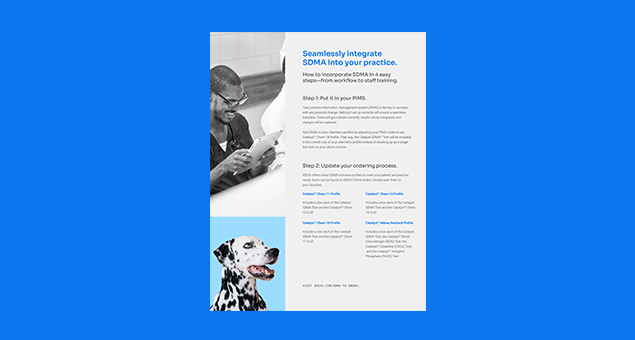
Integrate SDMA into your practice
This simple, step-by-step guide will show you exactly how to incorporate SDMA into your practice.
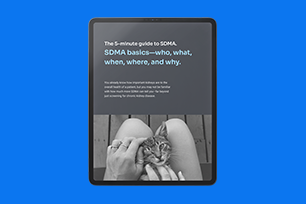
5-minute guide
The 5-minute guide to SDMA addresses the most common questions about SDMA so you can get valuable new insights with your regular chemistry protocols.

5-patient guide
Get simple to understand, yet in‑depth insights into the 5 patient types that can benefit most from SDMA testing. Breaking down the why (and how) it can lead to better outcomes for each.
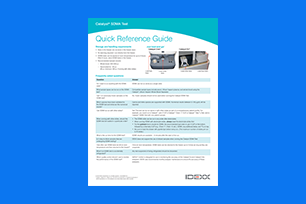
Quick reference guide
From how to store and handle the test, as well as answers to the most commonly-asked questions, it’s all in this simple, downloadable guide.
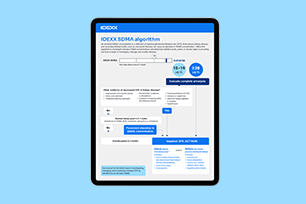
Algorithm
Follow this algorithm to investigate, classify the injury, and manage ongoing care when elevated SDMA levels indicate reduced glomerular filtration rate (GFR).
The training your team needs to detect CKD earlier.
A well-trained staff is vital to diagnosing and managing chronic kidney disease. This is where you’ll find SDMA courses to help staff spot signs of CKD, interpret labs, and guide pet owners through long-term care plans.
Understanding Glomerular Filtration Rate and Current Renal Biomarkers
How to Incorporate Early Functional Kidney Markers into All Patient Evaluations
Best Practices for Diagnosing and Staging Chronic Kidney Disease in Cats and Dogs
Dazzle: Using the IDEXX SDMA Algorithm to Investigate an Increased SDMA
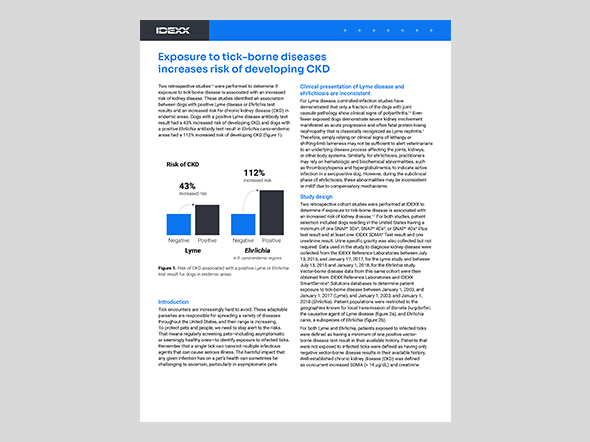
Learn more with our SDMA white papers.
This is where you’ll find white papers covering everything from an introduction to SDMA to feline hyperthyroid issues. Explore the selection and download what you need.
Explore a universe of veterinary insights in The Vetiverse.
Need a deeper understanding of how SDMA can give you earlier insights as well as new perspectives on kidney function and health? Browse expert articles for fast, practical knowledge you can use right away.

Detecting Kidney Disease in Pets Earlier: The Importance of Running SDMA in Every Profile.

How to Integrate SDMA Into Your Veterinary Practice Protocol

Why SDMA Testing Should Be Included in Wellness Cases
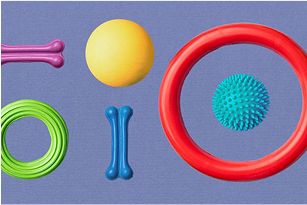
IRIS Staging of Chronic Kidney Disease in Pets for Improved Outcomes
FAQs
Studies have shown that lipemia and icterus do not affect the IDEXX SDMA result.1 Mild to moderate hemolysis does not impact IDEXX SDMA concentration, but IDEXX SDMA Test results may be depressed in markedly hemolyzed specimens. In addition, it is rare that SDMA cannot be measured in specimens with extreme hemolysis and lipemia. However, as with all laboratory testing, quality specimens free of lipemia and hemolysis are preferred to provide the most accurate results.
SDMA, like creatinine and GFR, has a biologic variability of 15%–20% from measurement to measurement in the same patient over a week or more. Therefore, changes need to be greater than this to indicate a true change and significant difference. For example, with 20% biologic variability, an initial SDMA result of 14 µg/dL could recheck anywhere from 11–17 µg/dL based on biologic variability alone, just like a creatinine of 1.5 mg/dL could vary from 1.2–1.8 mg/dL.1,2
Because SDMA correlates well to GFR,1,3–6 medication that affects GFR may result in changes to SDMA concentration.
SDMA is a surrogate marker for GFR.1,3–6 Biological variation of SDMA may range from 15%–20%, so it is important to consider this when interpreting any changes in SDMA.2 SDMA may also be affected by hydration status, so ideally, SDMA should be interpreted in a patient that is euvolemic and with a complete urinalysis to assess urine concentrating ability. SDMA may decrease in a dehydrated patient that is restored to euvolemia; however, it is important to also consider urine specific gravity when interpreting results.
SDMA is a surrogate marker of GFR1,3–6 and should not be affected by lower urinary tract infection in an otherwise well animal. In a patient with decreased GFR and/or underlying kidney disease, including AKI, SDMA may be increased, reflecting underlying changes in kidney function.
This has not been studied specifically in animals, but it has been confirmed that there is no correlation in dogs and cats between SDMA and serum arginine concentrations.1,7 In addition, in pregnant women with preeclampsia receiving prolonged supplementation with L-arginine, there was no impact on serum SDMA concentrations.8
SDMA correlates strongly with GFR.1,3–6 Dogs and cats demonstrate measured alterations in GFR, depending on the diet fed, and SDMA will be affected accordingly. However, unlike BUN, it is not expected that SDMA will be impacted by protein content of the diet or gastrointestinal bleeding independent of GFR.
Yes, using SDMA as a biomarker for CKD allows earlier diagnosis of CKD in both dogs and cats.3,4 Patients diagnosed with CKD and treated with a therapeutic renal diet experienced delayed progression of CKD as compared to patients fed a maintenance diet.5,9,10
The IDEXX SDMA Test is a sensitive kidney function test that helps to identify kidney disease in dogs and cats. If acute kidney injury is identified, then the underlying cause should be treated appropriately. If CKD has been diagnosed and SDMA and creatinine remain increased but stable, the animal should be staged using the IRIS CKD guidelines. We recommend veterinarians utilize the current IRIS treatment guidelines to help determine appropriate treatment.11
Dietary therapy is a key component for management of CKD in dogs and cats. Kidney therapeutic diets have controlled amounts of protein and are phosphorus-restricted, nonacidifying, and often supplemented with antioxidants and omega-3 fatty acids.
When deciding the appropriate time to begin feeding a kidney therapeutic diet to a patient with CKD, follow your clinical experience and utilize the current IRIS CKD treatment guidelines. According to the guidelines, it is appropriate to start a renal therapeutic diet when dogs and cats are in IRIS CKD Stage 1 if they have persistent renal proteinuria (UPC ratio greater than 0.4 in cats and 0.5 in dogs) or are in IRIS CKD Stage 2.11
For nonproteinuric, IRIS CKD Stage 1 dogs and cats, there is emerging evidence that feeding a renal-supportive diet can be beneficial.11
Starting a kidney therapeutic diet at the earliest appropriate time is ideal because transitioning to a new food should be more successful when the patient’s appetite is still good. Maintaining body weight and muscle is essential to successful management of CKD, and this is achieved primarily by adequate caloric intake.11
Note: SDMA is symmetric dimethylarginine.
References
- Nabity MB, Lees GE, Boggess MM, et al. Symmetric dimethylarginine assay validation, stability, and evaluation as a marker for early detection of chronic kidney disease in dogs. J Vet Intern Med. 2015;29(4):1036–1044. doi:10.1111/jvim.12835
- Kopke MA, Burchell RK, Ruaux CG, Burton SE, Lopez-Villalobos N, Gal A. Variability of symmetric dimethylarginine in apparently healthy dogs. J Vet Intern Med. 2018;32(2):736–742. doi:10.1111/jvim.15050
- Hall JA, Yerramilli M, Obare E, Yerramilli M, Jewell DE. Comparison of serum concentrations of symmetric dimethylarginine and creatinine as kidney function biomarkers in cats with chronic kidney disease. J Vet Intern Med. 2014;28(6):1676–1683. doi:10.1111/jvim.12445
- Hall JA, Yerramilli M, Obare E, Yerramilli M, Almes K, Jewell DE. Serum concentrations of symmetric dimethylarginine and creatinine in dogs with naturally occurring chronic kidney disease. J Vet Intern Med. 2016;30(3):794–802. doi:10.1111/jvim.13942
- Hall JA, Yerramilli M, Obare E, Yerramilli M, Yu S, Jewell DE. Comparison of serum concentrations of symmetric dimethylarginine and creatinine as kidney function biomarkers in healthy geriatric cats fed reduced protein foods enriched with fish oil, L-carnitine, and medium-chain triglycerides. Vet J. 2014;202(3):588–596. doi:10.1016/j.tvjl.2014.10.021
- Hall JA, Yerramilli M, Obare E, Yerramilli M, Melendez LD, Jewell DE. Relationship between lean body mass and serum renal biomarkers in healthy dogs. J Vet Intern Med. 2015;29(3):808–814. doi:10.1111/jvim.12607
- Sargent HJ, Elliott J, Jepson RE. The new age of renal biomarkers: does SDMA solve all of our problems? J Small Anim Pract. 2021;62(2):71–81. doi:10.1111/jsap.13236
- Rytlewski K, Olszanecki R, Korbut R, Zdebski Z. Effects of prolonged oral supplementation with L-arginine on blood pressure and nitric oxide synthesis in preeclampsia. Eur J Clin Invest. 2005; 35(1):32–37. doi:10.1111/j.1365-2362.2005.01445.x
- Hall JA, MacLeay J, Yerramilli M, et al. Positive impact of nutritional interventions on serum symmetric dimethylarginine and creatinine concentrations in client-owned geriatric dogs. PLoS One. 2016;11(4):e0153653. doi:10.1371/journal.pone.0153653
- Hall JA, MacLeay J, Yerramilli M, et al. Positive impact of nutritional interventions on serum symmetric dimethylarginine and creatinine concentrations in client-owned geriatric cats. PLoS One. 2016;11(4):e0153654. doi:10.1371/journal.pone.0153654
- IRIS guidelines. International Renal Interest Society. Accessed July 21, 2025. www.iris-kidney.com/iris-guidelines-1